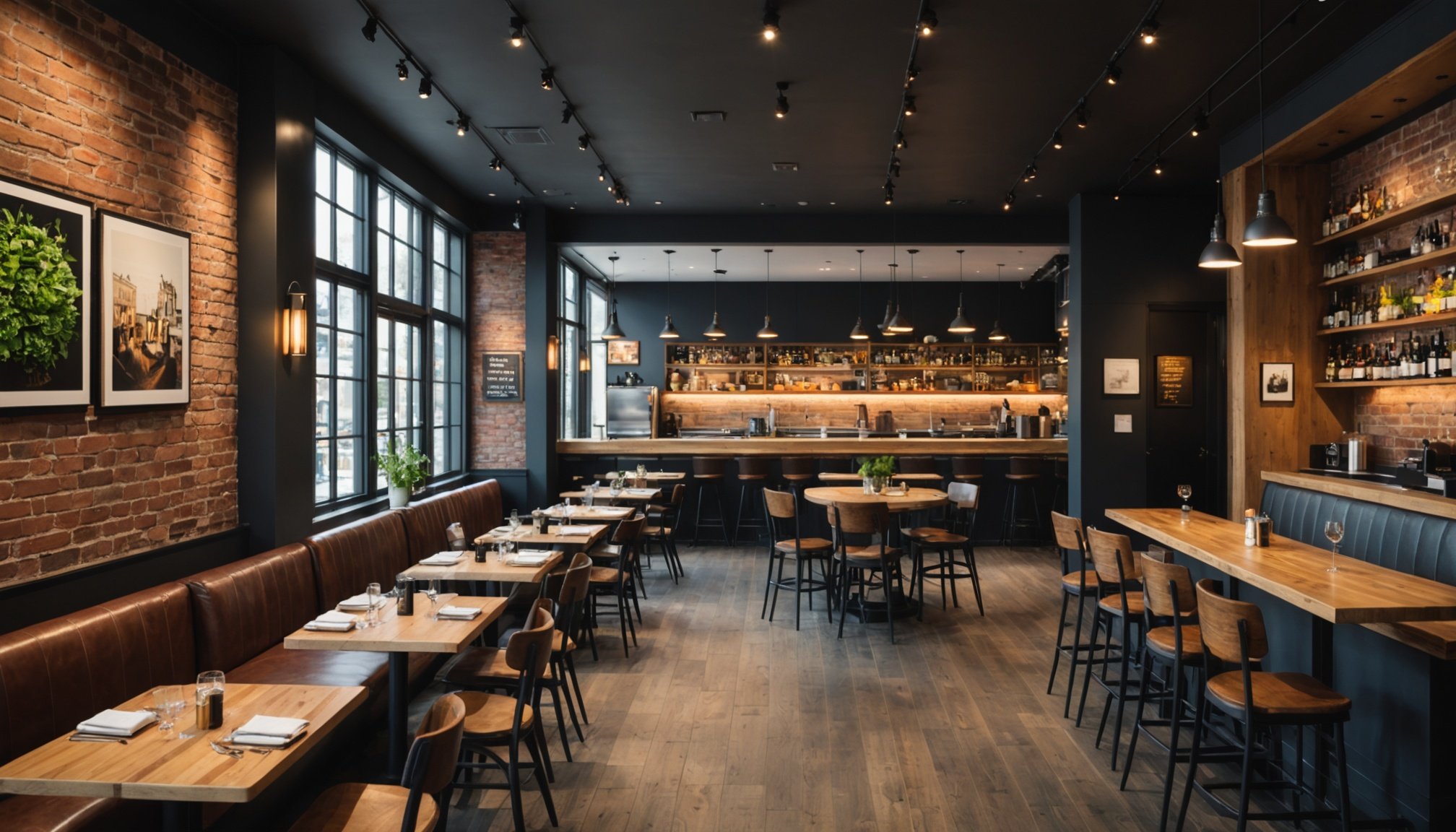Sustainable restaurant design does more than reduce environmental impact; it creates inviting spaces that resonate with conscious consumers. Consider energy-efficient lighting, locally sourced materials, and waste-reduction practices to enhance your brand's integrity. These factors not only contribute to sustainability but also elevate the dining experience. Explore how thoughtful design choices can align your values with customer expectations while fostering community engagement and promoting a healthier planet. Embrace innovation as you create a restaurant that leaves a lasting impression on both guests and the environment.
Importance of Sustainable Restaurant Design
Sustainable restaurant design is increasingly pivotal in today's industry landscape. Embracing eco-friendly practices not only aligns with global environmental goals but also offers tangible benefits for businesses. Sustainable design reduces energy consumption, minimizes waste, and enhances a restaurant's reputation among environmentally conscious consumers.
Also to see : Mastering the art of an enticing live cooking station for your buffet restaurant: the definitive guide
Trends in Sustainable Restaurant Design are reshaping how establishments operate. Many restaurants are now adopting energy-efficient appliances, utilizing recycled materials in construction, and implementing water-saving measures. These eco-friendly practices not only decrease operational costs but also attract a growing demographic of eco-conscious diners.
A commitment to restaurant sustainability can also foster community goodwill. By sourcing local and organic ingredients, restaurants can support local economies and reduce their carbon footprint. This holistic approach to sustainable design ensures that the benefits extend beyond the business itself, contributing positively to the environment.
Also to see : Unlock the benefits of using reclaimed materials for your restaurant”s interior design makeover
- Energy-efficient lighting
- Recycled building materials
- Water-saving fixtures
The integration of these elements into the restaurant's infrastructure demonstrates a commitment to sustainable design. By prioritizing eco-friendly practices, restaurants can achieve a balance between profitability and environmental responsibility, ensuring long-term success and sustainability.
Material Selection
Selecting the right materials is crucial for achieving sustainable restaurant design. This involves careful consideration of eco-friendly materials and their sustainable sourcing. By prioritizing recyclable materials, restaurants can significantly reduce their environmental impact.
Criteria for Selecting Sustainable Materials
When choosing materials, consider their environmental footprint, durability, and ease of recycling. Look for certifications like FSC for wood, which ensures responsible forest management. Opt for materials that require minimal processing and have a long lifespan to reduce waste.
Examples of Eco-friendly Materials
- Bamboo: A rapidly renewable resource, ideal for flooring and furnishings.
- Recycled Steel: Reduces energy consumption in production and is fully recyclable.
- Reclaimed Wood: Adds character and warmth while minimizing deforestation.
Importance of Local Sourcing
Local sourcing not only supports the community but also cuts down on transportation emissions. By choosing locally sourced materials, restaurants contribute to a sustainable sourcing strategy that benefits both the environment and local economies.
"The use of locally sourced, eco-friendly materials is a testament to a restaurant's commitment to sustainability."
Incorporating these principles into material selection ensures that restaurants can maintain their environmental responsibility while creating a unique and inviting space.
Energy Efficiency
Harnessing technology for sustainable operations
Key Technologies for Energy Efficiency
Adopting energy-efficient appliances is crucial for reducing a restaurant's energy consumption. These appliances, such as ENERGY STAR-rated ovens and refrigerators, are designed to use less power while maintaining performance. Implementing these technologies can significantly lower utility bills and reduce the environmental footprint.
Benefits of Renewable Energy
Incorporating renewable energy sources, like solar panels or wind turbines, offers restaurants a sustainable way to power their operations. Not only do these sources reduce dependency on fossil fuels, but they also provide long-term cost savings. Restaurants investing in renewable energy can benefit from tax incentives and enhance their eco-friendly image.
Strategies for Energy Conservation
To further conserve energy, restaurants can implement various strategies. Simple measures include installing LED lighting, which uses less electricity and lasts longer than traditional bulbs. Additionally, smart thermostats can optimize heating and cooling systems, ensuring energy is used efficiently.
- LED Lighting: Reduces energy usage and costs.
- Smart Thermostats: Enhances temperature control.
- Energy-efficient Appliances: Lowers power consumption.
"Investing in energy-efficient technologies is not just a choice; it's a commitment to the future."
By prioritizing these energy-efficient solutions, restaurants can achieve both environmental and economic benefits, ensuring sustainable operations for years to come.
Waste Management
Implementing effective strategies for reducing waste in restaurants
Importance of a Comprehensive Waste Management Strategy
A well-structured waste management strategy is vital for modern restaurants aiming to reduce their environmental impact. By focusing on waste reduction, restaurants can minimize costs and improve operational efficiency. This approach not only benefits the environment but also enhances the establishment's reputation among eco-conscious patrons.
Implementing Recycling and Composting Programs
To achieve effective waste management, restaurants should implement robust recycling programs and composting initiatives. Recycling programs help in segregating materials such as glass, paper, and plastics, ensuring they are processed correctly. Meanwhile, composting organic waste reduces landfill contributions and produces valuable fertilizer for local agriculture.
"Effective waste management is not just a practice; it's a responsibility."
Case Studies of Successful Waste Management in Restaurants
Several restaurants have successfully adopted waste management strategies that emphasize waste reduction. For instance, a popular urban bistro reduced its waste by 50% through a comprehensive recycling program. Another eco-friendly eatery implemented composting, turning food scraps into nutrient-rich soil, thereby supporting local farms.
- Recycling Programs: Essential for material segregation.
- Composting: Transforms waste into valuable resources.
- Waste Reduction: Key to sustainable operations.
By integrating these practices, restaurants can significantly contribute to environmental sustainability and operational excellence.
Water Conservation
Smart approaches to efficient water use in restaurants
Innovative Water-saving Fixtures and Technologies
Integrating water-saving fixtures is essential for restaurants aiming to conserve water. Modern innovations include low-flow faucets and dual-flush toilets, which significantly reduce water usage. These technologies are designed to maintain performance while minimizing waste. For example, aerators can be added to existing taps to cut water flow without affecting pressure.
Practices for Reducing Water Usage
Implementing efficient water use practices is crucial in restaurant operations. Simple actions, such as fixing leaks promptly and using dishwashers only at full capacity, can lead to substantial savings. Additionally, training staff on water management strategies ensures that everyone contributes to conservation efforts. Regular audits of water usage can highlight areas for improvement.
Importance of Water Management in Sustainability
Effective water management strategies are integral to a restaurant's sustainability goals. By reducing water consumption, restaurants not only lower operational costs but also lessen their environmental impact. This commitment to efficient water use resonates with eco-conscious customers, enhancing the restaurant's reputation.
- Low-flow Faucets: Reduce water consumption.
- Dual-flush Toilets: Offer water-saving options.
- Water Audits: Identify areas for improvement.
"Water conservation is not just a necessity; it's a responsibility that ensures sustainable operations."
Indoor Air Quality
Enhancing the atmosphere for health and comfort
Importance of Good Indoor Air Quality
Indoor air quality is crucial for the well-being of both customers and staff. Poor air quality can lead to health issues such as allergies and respiratory problems, impacting overall satisfaction and productivity. Ensuring optimal air quality improvement is not just a health measure but also a commitment to a safe dining environment.
Strategies for Improving Ventilation and Air Quality
Implementing effective ventilation systems is a primary strategy for maintaining high indoor air quality. These systems help in circulating fresh air, removing contaminants, and regulating humidity. Restaurants can enhance air quality by incorporating air purifiers and regularly maintaining HVAC systems.
- Air Purifiers: Capture pollutants and allergens.
- Regular Maintenance: Ensures efficient operation.
- Humidity Control: Prevents mold and mildew growth.
Sustainable Materials and Their Impact
The choice of sustainable materials can significantly affect indoor air quality. Materials like low-VOC paints and natural fibers release fewer pollutants, contributing to a healthier atmosphere. By selecting materials that promote better air quality, restaurants demonstrate their dedication to both sustainability and the health of their patrons.
"Investing in ventilation systems and sustainable materials is a proactive step towards a healthier environment."
Case Studies and Expert Insights
Exploring successful sustainable design examples offers valuable insights into best practices for the restaurant industry. These case studies highlight the innovative strategies employed by various establishments to achieve environmental sustainability.
Overview of Successful Sustainable Restaurant Designs
Several restaurants have become pioneers in sustainable design by incorporating eco-friendly materials and energy-efficient technologies. For instance, a renowned urban bistro utilized reclaimed wood and recycled steel, significantly reducing its carbon footprint. Another example is a coastal restaurant that installed solar panels, cutting energy costs by 30%.
Industry Expert Opinions
Insights from industry experts underscore the importance of sustainable design. According to Jane Doe, a leading sustainability consultant, "Integrating eco-friendly practices is not just a trend; it's essential for future-proofing businesses." Experts emphasize the role of sustainable design in enhancing brand reputation and customer loyalty.
Lessons Learned from Case Studies
These case studies reveal several key lessons for implementing sustainable design:
- Focus on Local Sourcing: Reduces transportation emissions.
- Invest in Renewable Energy: Long-term cost savings and environmental impact.
- Engage with Community: Builds goodwill and supports local economies.
"Successful sustainable design requires a holistic approach, balancing environmental responsibility with business goals."











